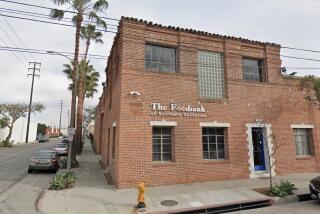No Wheels, No Meals : Hard-Pressed Food Bank Halts Deliveries to Local Charities
- Share via
Until recently, the deliveries arrived like clockwork: Every Monday afternoon, a truck would roll into St. Jane Frances Catholic Church in North Hollywood loaded with butter, cereal, rice, tuna and other staples.
The neighborhood poor arrived just as regularly, lining up four days a week to collect a bag of groceries from the church pantry.
But now the pantry at St. Jane Frances is nearly bare, three weeks after the regional food bank cut off its delivery service.
The people, however, continue to come for food.
The end to deliveries was necessitated by declining financial donations and federal aid to the Los Angeles Regional Foodbank, the major supply line for hundreds of the region’s food-giveaway programs, said the agency’s executive director, Doris Bloch.
Food is still available. But recipient organizations now must pick it up themselves, and 48 smaller food pantries depended on the delivery service because they had no trucks or loading crews. However, Bloch said 707 agencies are unaffected by the halt in deliveries because they pick their food up from the bank.
“We’re doing all the things organizations do when they are facing a bleak financial future,” Bloch said.
“I hated to do it, but we just didn’t have a viable alternative. One day maybe we can do it again, but I have told (food distribution charities) they should not rely on this, that they should get together and hire their own vehicles.”
For the few dozen affected, the impact is significant.
While none of the food pantries, shelters and rescue missions that depended on the Los Angeles Regional Foodbank for deliveries have had to stop doling out food, many have had to cut back on what they give away and some have even resorted to buying food from supermarkets to save the time a cross-town trip would take.
“Some of the things we have to buy ourselves, and we’ve also had to put less food in the bags we give out,” said Sister Teresa Walsh, director of the giveaway program at St. Jane Frances. “We’ve really had to cut back so that we can still accommodate everyone.”
In 1994, the regional food bank distributed about 3.8 million pounds of goods through its Food Partnership Delivery Program--about one-10th the amount the organization provided.
But last year, the $80,000 delivery program ran a $14,000 deficit, Bloch said, and the agency could not afford to continue it.
One-quarter of the agencies that relied on the deliveries were in the San Fernando and Santa Clarita valleys, which are among the farthest recipients from the food bank’s warehouse in South-Central Los Angeles.
“We depend on them for everything, not only (U.S. Department of Agriculture) items like rice and beans and butter, but everything else, too,” said Carmen Mathews, executive director of the Santa Clarita Valley Food Pantry. “That’s a long trek, and not getting the deliveries had a tremendous impact.”
In the meantime, the pantry, which serves 2,000 meals per month, has been dependent on a volunteer truck driver who makes the run to south Los Angeles when he has the time. This week, Mathews said, the pantry had to do without a delivery.
“Now we might have to rent a truck, (and get) a driver and insurance,” she said.
Added Steve Blake, who oversees 12 food pantries for the San Fernando Valley Interfaith Council: “We’re sort of scrambling.”
Besides being forced to hand out less food, local charities say another problem is that many of their volunteers are elderly men and women unable to lift crates of food.
“I’d say the average age of most of us is at 70 or 71, so it makes it difficult,” said Jerry Rosenstock, director of the North Hollywood Interfaith Food Pantry. “I’m 73, and sometimes I move a little slow. Heck, we all do.”
Rosenstock said when his pantry ran out of tuna to put in its grocery bags, they substituted tamales. Now, the tamales are running low. “What it does,” he said, “is put a great pressure on us.”
Yet many organizations have made a relatively smooth transition.
At the First Presbyterian Church of Hollywood, deacons programs director Letty Liu said they have enough volunteers and vehicles to pick up the food themselves.
“The Foodbank does the best they can,” Liu said. “When they have a problem, we try to solve it.”
Times staff writer Sonia Nazario contributed to this story.
More to Read
Sign up for Essential California
The most important California stories and recommendations in your inbox every morning.
You may occasionally receive promotional content from the Los Angeles Times.













